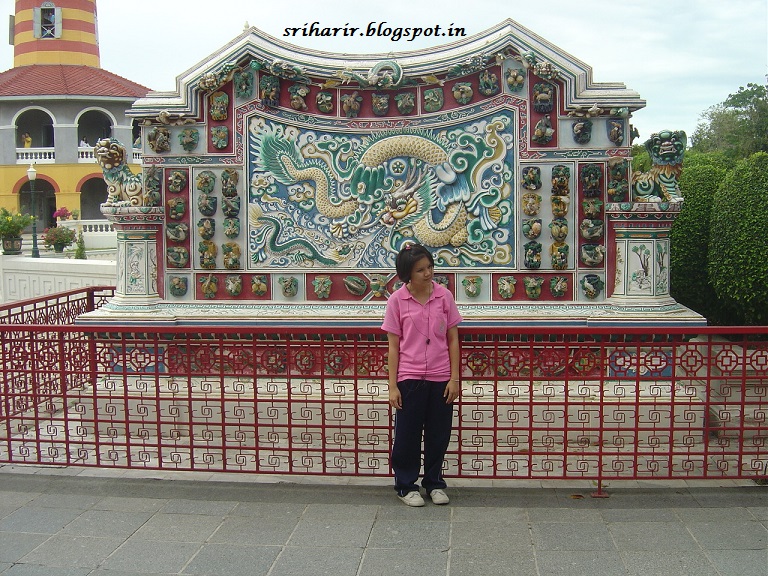Travalogue - India and Overseas
Thursday, 15 August 2013
Travelogue_ Thailand Chatuchak Weekend market
Thailand Chatuchak Weekend Market
Chatuchak
weekend market in Bangkok is the largest market in Thailand and the world's
largest weekend market. Frequently called J.J., it covers over 35 acres
(0.14 km²) and contains upwards of 15,000 stalls. It is estimated that the
market receives 200,000 visitors each day.
Most stalls only open on Saturdays and Sundays though Jatujak Plaza, the
western section is open daily. In the north west corner is the J.J. Mall, with
three floors of assorted oddments as well as eateries. Chatuchak
market is adjacent to the amphaengphet
station of the MRT Blue Line, or about a 5-minute walk from the Mo Chit
station of the BTS Skytrain Sukhumvit Line and another MRT station, Chatuchak
Park.
We have purchased the items as below for a bargain from 20 % to 10 %. The Tender coconuts are cut in a different style and it taste very good and filling. You should try this atleast once.
We have purchased the items as below for a bargain from 20 % to 10 %. The Tender coconuts are cut in a different style and it taste very good and filling. You should try this atleast once.
Courtesy
: Wikipedia
Rangarajan Ramaswamy Bangalore 15.08.2013
Wednesday, 14 August 2013
Travelogue_ River cruise_ Ayuthaya to Bangkok
Thailand River Cruise - August 2011
The Chao Phraya
is a major river in Thailand, with its low alluvial plain forming the centre of
the country. It flows through Bangkok and then into the Gulf of Thailand.
Bangkok Ring Road Cable-stayed Bridge
To alleviate traffic congestion in Bangkok, which has become
increasingly serious in recent years, the construction of a ring road annularly
connecting the international port isolated by the meandering Chao Phraya River
and two huge industrial complexes was carried out as a national project under
the direction of HM the King of Thailand. Described here are the twin
cable-stayed bridges among the bridges extending about 8 km in total,
constructed in the locations where the ring road crosses the River.
View from our camera from the Cruise Ship
Rangarajan Ramaswamy Bangalore 15.08.2013
Travelogue_ Thailand- Ayuthaya
Thailand_ Ayuthaya - August 2011
Ayutthaya City is the capital of Ayutthaya
province in Thailand. Located in the valley of the Chao Phraya River, the city
was founded in 1350 by King U Thong, who went there to escape a smallpox
outbreak in Lop Buri and proclaimed it the capital of his kingdom, often
referred to as the Ayutthaya kingdom or Siam. Ayutthaya became the second
Siamese capital after Sukhothai. Its remains, characterized by the
prang (reliquary towers) and gigantic monasteries, give an idea of its past splendor.
It is estimated that Ayutthaya by the year 1600 CE had a population of about
300,000, with the population perhaps reaching 1,000,000 around 1700 CE, making
it one of the world's largest cities at that time. In 1767, the city was destroyed
by the Burmese army, resulting in the collapse of the kingdom. The Ayutthaya
historical park is the ruins of the former capital of the Kingdom of Siam. It
is the site of sacked and destruction of the Ayutthaya city, its art and
buildings by the Burmese in 1767, which is recognized internationally as a UNESCO World Heritage Site. The city was refounded a few kilometers
to the east. The city is sometimes called "Venice of the East".
Courtesy
: Wikipedia
Rangarajan Ramaswamy Bangalore 15.08.2013
Travelogue_ Thailand - Bang Ma Palace
Thailand_Bang Ma Palace
Bang Pa-In Royal Palace, also known as
the Summer Palace, is a palace complex formerly
used by the Thai kings. The palace is located on the Chao Phraya River bank in Bang
Pa-In district, Ayutthaya Province.
King Prasat Thong originally constructed the complex in
1632, and though it lay empty and overgrown throughout the late 18th and early
19th centuries, King Mongkut began to restore the site in the mid-19th century.
Most of the present buildings were constructed between 1872 and 1889 by King Chulalongkorn.
The facilities include vast gardens and landscaping,
Wehart Chamrunt (Heavenly Light), a Chinese-style royal palace and throne room;
the Warophat Phiman (Excellent and Shining Heavenly Abode), a royal residence;
Ho Withun Thasana (Sages' Lookout), a brightly painted lookout tower; and the
Aisawan Thiphya-Art (Divine Seat of Personal Freedom), a pavilion constructed
in the middle of a pond.
The palace remains largely open to visitors, as King Bhumibol
Adulyadej and his family use it only rarely for banquets and special occasions.
The Courtesy : Wikipedia
Aisawan Dhiphya-Asana Pavilion
Rangarajan Ramaswamy Bangalore 15.08.2013
Subscribe to:
Comments (Atom)






























































